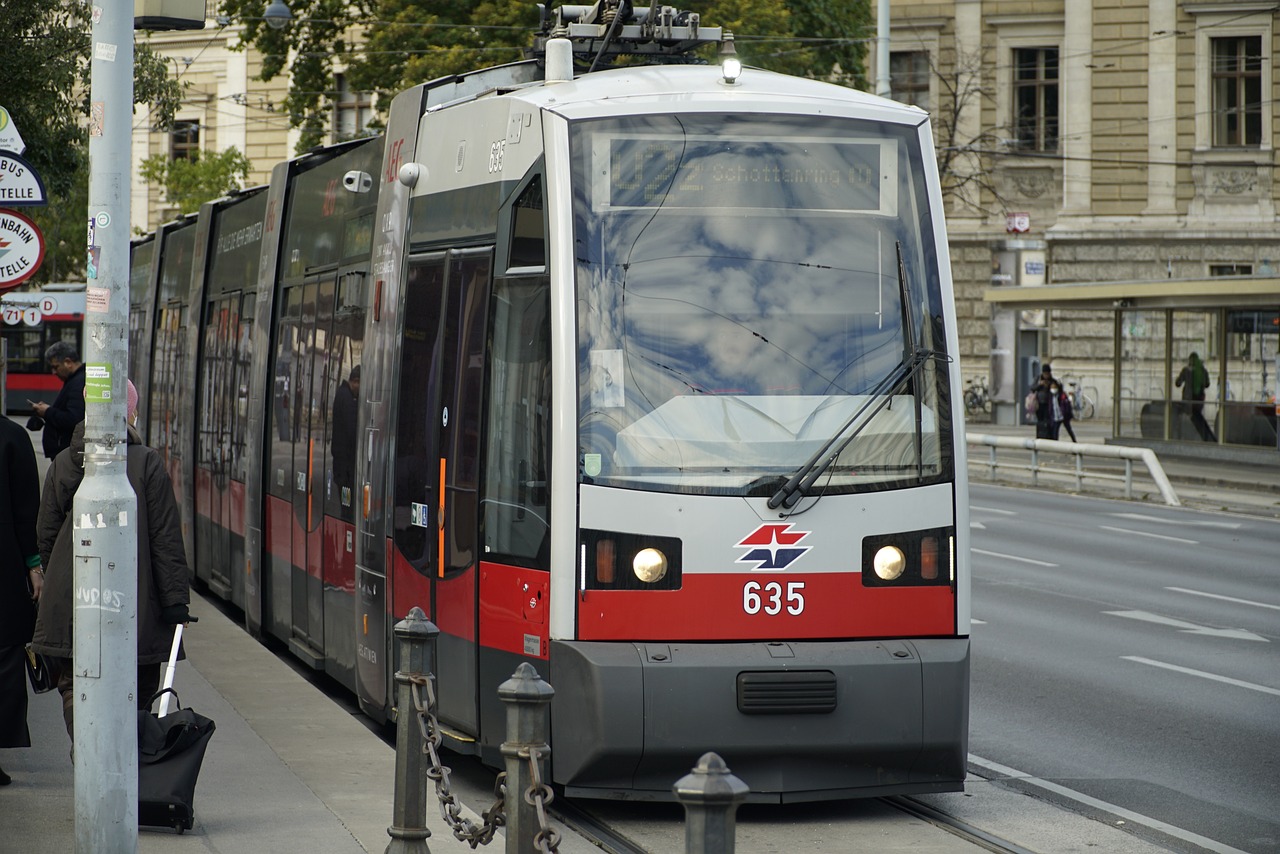Eco-Friendly Transport Alternatives for Daily Commute
In a world where environmental concerns are becoming increasingly urgent, it’s time to rethink how we get from point A to point B. Daily commuting can contribute significantly to carbon emissions, traffic congestion, and air pollution. Fortunately, there are eco-friendly transport alternatives that not only benefit the planet but also enhance our personal well-being. This article will explore various sustainable transport options available for daily commuting, highlighting their benefits, challenges, and impact on the environment, encouraging readers to make greener choices in their travel routines.
Bicycling is not just a mode of transport; it’s a lifestyle choice that promotes both physical health and environmental sustainability. Picture this: you hop on your bike, the wind in your hair, as you glide past traffic jams and pollution. Cycling is an incredibly cost-effective way to commute, especially for short distances. You save money on gas, parking fees, and even gym memberships! Plus, it’s a convenient option that allows you to navigate through urban areas with ease. However, it’s essential to consider safety measures and the availability of bike lanes to fully embrace this green choice.
Utilizing public transport systems like buses and trains can significantly lower individual carbon footprints. Imagine boarding a bus filled with fellow commuters, all of you contributing to a shared goal of reducing emissions. Public transportation not only cuts down on the number of cars on the road, but it also helps reduce traffic congestion and lowers transportation costs. In fact, studies show that cities with robust public transit systems experience less pollution and more efficient traffic flow. However, challenges such as scheduling and overcrowding can sometimes deter people from using these services.
Carpooling is an effective way to cut down on emissions and travel costs while also fostering community connections. Think of it as a social event on wheels! By sharing rides with others, you not only reduce the number of vehicles on the road but also create a sense of camaraderie among commuters. It’s a win-win situation! However, finding reliable carpool partners and coordinating schedules can be a bit tricky. But with the right apps and platforms, carpooling can become a seamless part of your daily routine.
Electric vehicles (EVs) are gaining popularity as a clean alternative to traditional cars. Imagine driving a car that not only helps you save on fuel costs but also contributes to a cleaner environment. EVs have lower operating costs compared to gasoline vehicles, and they significantly decrease reliance on fossil fuels. As charging infrastructure improves and battery technology advances, the future of commuting looks bright for electric vehicle owners. However, the initial purchase price can be a hurdle for some, but government incentives and decreasing prices are making EVs more accessible.
Walking is the most basic form of eco-friendly transport, promoting health and wellness while being entirely free! For short distances, it’s hard to beat the simplicity of putting one foot in front of the other. Think about it: walking not only reduces your carbon footprint but also improves your cardiovascular health and mental well-being. Plus, it allows you to experience your surroundings in a way that driving simply can’t match. However, urban environments must prioritize pedestrian-friendly infrastructure to make walking a safe and appealing option.
Hybrid vehicles combine traditional fuel engines with electric power, offering a more sustainable alternative for those who aren’t ready to go fully electric. They serve as a bridge between conventional cars and electric vehicles, allowing drivers to enjoy better fuel efficiency and lower emissions. With the rising cost of fuel, hybrids can also help you save money at the pump. However, the complexity of hybrid technology can lead to higher maintenance costs, so it’s important to research and choose wisely.
Shared mobility services, such as ride-sharing and bike-sharing, provide flexible transport solutions that cater to modern lifestyles. Imagine having the ability to summon a ride or borrow a bike with just a few taps on your smartphone. These services can enhance urban mobility while reducing the need for personal vehicle ownership. They promote a culture of sharing and can significantly lower the number of cars on the road. However, the availability and reliability of these services can vary greatly depending on your location.
Telecommuting has gained traction as a sustainable transport alternative by minimizing the need for daily travel. Imagine being able to work from the comfort of your home, avoiding the daily grind of commuting altogether. This not only saves time and money but also significantly reduces traffic and emissions. As more companies embrace remote work policies, the positive implications for urban environments are becoming clearer. However, it’s crucial to maintain productivity and work-life balance when working from home.
Emerging technologies like autonomous vehicles and hyperloop systems promise to revolutionize daily commuting. Picture a world where self-driving cars whisk you to your destination while you relax or catch up on work. Innovations like these have the potential to create more sustainable and efficient transport networks. However, regulatory challenges and public acceptance will play significant roles in shaping the future of these technologies.
- What are the most eco-friendly transport options? Bicycles, public transport, walking, and electric vehicles are some of the top choices.
- How can I encourage others to use public transport? Share your positive experiences, highlight cost savings, and promote the environmental benefits.
- Are electric vehicles really better for the environment? Yes, they produce fewer emissions over their lifetime compared to traditional gasoline-powered vehicles.
- What are the benefits of carpooling? Reduced costs, lower emissions, and the opportunity to meet new people are just a few advantages.

Bicycles: The Green Choice
Bicycling is not just a mode of transport; it's a lifestyle choice that embodies sustainability and health. Imagine gliding through the fresh air, feeling the wind on your face, and knowing that with every pedal, you are contributing to a cleaner planet. Bicycles are the green choice for daily commuting, offering a multitude of benefits that make them an attractive option for anyone looking to reduce their carbon footprint.
One of the most significant advantages of cycling is its impact on physical health. Regular biking can improve cardiovascular fitness, strengthen muscles, and enhance mental well-being. It's like hitting two birds with one stone: you get your daily exercise while also choosing an eco-friendly way to travel. Plus, cycling is incredibly cost-effective. With no fuel costs, minimal maintenance expenses, and the potential for tax incentives in some areas, it’s a smart financial decision as well.
Convenience is another compelling reason to hop on a bike. For short-distance commutes, bicycles can often outpace cars, especially in congested urban areas where traffic jams can turn a quick trip into a frustrating ordeal. Imagine zipping past idling cars, arriving at your destination feeling invigorated rather than stressed. Additionally, many cities are investing in bike lanes and cycling infrastructure, making it safer and easier than ever to choose cycling as your primary mode of transport.
However, it's essential to acknowledge some challenges that come with cycling. Weather conditions can be unpredictable, and not everyone may feel comfortable riding in the rain or snow. Furthermore, for those who live in hilly areas, the physical exertion can be daunting. But fear not! With the rise of electric bicycles, even the most challenging terrains can become manageable. These e-bikes provide a little extra boost, making cycling accessible to a broader audience.
In conclusion, embracing cycling as a daily commute option is a win-win situation. Not only does it promote a healthier lifestyle, but it also plays a crucial role in reducing greenhouse gas emissions. So, why not consider swapping your car keys for a bike lock? Every small change counts, and by choosing to ride a bicycle, you are making a significant impact on both your health and the environment.
- What are the health benefits of cycling? Cycling improves cardiovascular health, strengthens muscles, and boosts mental well-being.
- Is cycling cost-effective compared to driving? Yes, cycling eliminates fuel costs and has lower maintenance expenses.
- What if I live in a hilly area? Electric bicycles can help make cycling easier in challenging terrains.
- How can I stay safe while cycling? Always wear a helmet, use bike lanes, and follow traffic rules.

Public Transportation: A Collective Solution
Public transportation is often hailed as a collective solution to some of the most pressing issues of our time, such as traffic congestion, air pollution, and the ever-increasing cost of commuting. By utilizing systems like buses, trains, and subways, individuals can significantly reduce their carbon footprints. Imagine a world where fewer cars clog the streets, where the air is cleaner, and where people can travel without the stress of parking or fuel costs. This is not just a dream; it’s a reality that public transport can help create.
One of the most compelling advantages of public transportation is its ability to lower individual transportation costs. For many, owning a car can be a financial burden, encompassing expenses such as fuel, maintenance, insurance, and parking fees. In contrast, public transport offers a more economical option. For instance, a monthly bus pass can cost significantly less than maintaining a vehicle. According to a recent study, individuals who regularly use public transportation can save over $10,000 a year compared to those who drive.
Additionally, public transportation systems are designed to accommodate large numbers of people, which helps to alleviate traffic congestion. When more people choose to ride buses or trains instead of driving, the roads become less crowded, leading to shorter travel times for everyone. Furthermore, fewer vehicles on the road translate to reduced wear and tear on infrastructure, which can save municipalities money in the long run.
However, the benefits of public transportation extend beyond just economic savings. It also plays a crucial role in promoting sustainability. By opting for public transit, we can collectively reduce greenhouse gas emissions. For example, a single bus can replace dozens of cars on the road, significantly cutting down on emissions. To illustrate this point, consider the following table that compares the average emissions per passenger mile for different modes of transport:
| Mode of Transport | Average Emissions (grams CO2 per passenger mile) |
|---|---|
| Car (single occupancy) | 404 |
| Bus | 105 |
| Train | 45 |
| Bicycle | 0 |
This table clearly demonstrates that public transport options like buses and trains produce far less pollution per passenger compared to individual car travel. By choosing to ride, you not only contribute to a cleaner environment but also encourage others to make similar choices, creating a ripple effect of positive change within your community.
Of course, public transportation is not without its challenges. Issues such as reliability, coverage, and safety can deter some individuals from using these services. However, as cities invest more in their transit systems and work towards improving service quality, the benefits can far outweigh the drawbacks. Enhanced public transport infrastructure can lead to greater accessibility, making it easier for everyone to commute without relying on personal vehicles.
In conclusion, public transportation is more than just a means of getting from point A to point B; it is a collective solution that can lead to a healthier planet, a more connected community, and a more sustainable future. By embracing public transport, we can not only save money but also contribute to a larger movement aimed at reducing our environmental impact. So, the next time you consider your commuting options, think about hopping on a bus or train. You might just find it’s the best decision for both your wallet and the world.
- What are the benefits of using public transportation? Public transportation can save you money, reduce traffic congestion, and lower your carbon footprint.
- Is public transportation safe? Most public transportation systems prioritize safety and have regulations in place to ensure the well-being of passengers.
- How can I find public transportation options in my area? You can use local transit authority websites or apps to find routes, schedules, and fares.

Carpooling: Sharing the Ride
Carpooling is more than just a convenient way to share a ride; it's a community-driven solution that brings numerous benefits to both individuals and the environment. Imagine this: instead of each person driving their own car, contributing to traffic congestion and pollution, a group of friends or coworkers hops into one vehicle. This simple act can lead to significant reductions in carbon emissions, making a profound impact on our planet. Not only does carpooling help in reducing the number of cars on the road, but it also fosters a sense of community and connection among participants.
One of the most appealing aspects of carpooling is its cost-effectiveness. By sharing the ride, individuals can split fuel costs and reduce wear and tear on their vehicles. For instance, if four people carpool to work, they can save up to 75% on fuel expenses compared to driving alone. This not only puts more money back in your pocket but also encourages a more sustainable approach to commuting.
However, carpooling isn't just about saving money; it also plays a crucial role in reducing traffic congestion. With fewer cars on the road, commutes become smoother and less stressful. Think about rush hour—it's often characterized by gridlock and frustration. But when more people choose to carpool, the roads become less congested, leading to faster travel times for everyone. Additionally, fewer vehicles mean less wear and tear on infrastructure, which can lead to lower maintenance costs for local governments.
Of course, like any solution, carpooling comes with its own set of challenges. Coordinating schedules can be tricky, and finding reliable carpool partners is essential. However, with the advent of technology, several apps and platforms have emerged to facilitate this process. These tools can help users find carpool matches based on their routes and schedules, making it easier than ever to connect with others who are looking to share a ride.
Moreover, carpooling can also enhance social interactions. It provides an opportunity to meet new people and strengthen relationships with colleagues or neighbors. Picture this: instead of commuting in isolation, you’re engaging in lively conversations, sharing stories, and maybe even discovering common interests. This social aspect can make the daily commute feel less like a chore and more like a chance to connect.
In summary, carpooling is a powerful tool for creating a more sustainable future. By reducing emissions, saving money, easing traffic congestion, and fostering community connections, it offers a win-win situation for everyone involved. So, next time you're planning your commute, consider reaching out to friends or colleagues to see if they’d like to share the ride. Together, we can make a difference—one carpool at a time!
- What is carpooling? Carpooling involves sharing a ride with others who are going in the same direction, reducing the number of vehicles on the road.
- How can I find carpool partners? There are various apps and websites designed to connect individuals looking for carpool opportunities based on their routes and schedules.
- What are the environmental benefits of carpooling? Carpooling reduces carbon emissions, alleviates traffic congestion, and decreases the overall number of vehicles on the road, contributing to a cleaner environment.
- Is carpooling safe? Yes, as long as you take precautions such as vetting your carpool partners and establishing clear communication regarding safety measures.

Electric Vehicles: The Future of Commuting
As we stand on the brink of a transportation revolution, electric vehicles (EVs) are not just a trend; they are becoming a necessity. Imagine a world where your daily commute contributes to a cleaner planet instead of polluting it. With advancements in technology, EVs are paving the way for a sustainable future, reducing our reliance on fossil fuels and minimizing harmful emissions. But what makes these vehicles so appealing? Let's dive into their benefits and explore why they are the future of commuting.
First and foremost, one of the most significant advantages of electric vehicles is their environmental impact. Unlike traditional gasoline-powered cars, EVs produce zero tailpipe emissions, which means cleaner air for everyone. According to recent studies, switching to electric vehicles could reduce greenhouse gas emissions by up to 70% in urban areas. This is a huge leap toward combating climate change and improving air quality, benefiting not just the environment but also public health.
Moreover, electric vehicles offer substantial cost savings over time. While the initial purchase price of an EV might be higher than that of a conventional vehicle, the total cost of ownership is often lower due to reduced fuel costs and maintenance expenses. For instance, charging an EV can be significantly cheaper than filling up a gas tank, and with the increasing availability of charging stations, it's becoming easier than ever to keep your vehicle powered. Take a look at the comparison below:
| Expense Type | Gasoline Vehicle | Electric Vehicle |
|---|---|---|
| Fuel Cost (per mile) | $0.12 | $0.04 |
| Maintenance Cost (annual) | $1,200 | $600 |
| Tax Incentives | None | Up to $7,500 |
But the benefits don’t stop there! Electric vehicles also come equipped with advanced technology that enhances the overall driving experience. Features like regenerative braking, which captures energy during braking to recharge the battery, and sophisticated navigation systems that help locate charging stations, make EVs not just eco-friendly but also user-friendly. It's like having a personal assistant that ensures you never run out of juice on the road!
However, transitioning to electric vehicles does come with its own set of challenges. One of the most common concerns is the range anxiety experienced by potential buyers. Many people worry about how far they can travel on a single charge. Fortunately, advancements in battery technology are rapidly improving the range of electric vehicles, with many models now offering over 300 miles on a single charge. Plus, the growing network of charging stations means that finding a place to recharge is becoming less of a hassle.
In conclusion, electric vehicles represent a transformative shift in how we think about commuting. They not only promise to reduce our carbon footprint but also offer significant financial benefits and advanced technology that enhance our daily driving experiences. As we continue to innovate and adapt to this new era of transportation, embracing electric vehicles could be one of the best choices we make for both our wallets and the planet.
- What are the main benefits of owning an electric vehicle? Electric vehicles offer environmental benefits, cost savings, and advanced technology features.
- How far can I drive on a single charge? Many modern EVs can travel over 300 miles on a single charge, depending on the model and driving conditions.
- Are there enough charging stations available? Yes, the network of charging stations is rapidly expanding, making it easier to find a charging point.
- What incentives are available for purchasing an electric vehicle? Many governments offer tax credits and rebates that can significantly reduce the purchase price of an EV.

Walking: The Simplest Solution
Walking is often overlooked as a viable form of transportation, yet it's one of the most straightforward and eco-friendly options available to us. Imagine stepping out of your front door, feeling the fresh air on your face, and knowing that every step you take is not only benefiting your health but also the planet. Walking is a natural form of movement that requires no fuel, produces no emissions, and can be done almost anywhere. It’s like having a personal transport system that’s always ready to go!
When it comes to short distances, walking is often the quickest and easiest way to get from point A to point B. In urban environments, where traffic congestion can turn a simple drive into a frustrating ordeal, walking can save time and sanity. Think about it: instead of sitting in a car, stuck in traffic, you could be enjoying a leisurely stroll, soaking up the sights and sounds of your neighborhood. Plus, it’s a fantastic way to clear your mind and reduce stress.
Not only does walking improve your physical health by promoting cardiovascular fitness and strengthening muscles, but it also has profound mental health benefits. Studies have shown that walking can help alleviate symptoms of anxiety and depression, enhance mood, and boost overall well-being. It’s like taking a mini-vacation every time you step outside!
Furthermore, walking contributes to a cleaner environment. By choosing to walk instead of driving, you’re reducing the number of cars on the road, which in turn decreases air pollution and greenhouse gas emissions. This is especially important in urban areas where air quality can be a significant concern. Imagine if more people chose to walk; the positive impact on our cities would be monumental!
While walking is an excellent choice for many, there are some challenges to consider. For instance, not every area is pedestrian-friendly. Sidewalks may be lacking, or traffic can be dangerous. However, many cities are beginning to recognize the importance of walkability and are investing in infrastructure to make walking safer and more enjoyable. The rise of pedestrian zones, improved crosswalks, and dedicated walking paths are all steps in the right direction.
Here are some tips to make walking a more integral part of your daily routine:
- Choose walking-friendly routes: Look for paths that are well-maintained and safe.
- Combine walking with errands: If you have a grocery store or café nearby, consider walking instead of driving.
- Set walking goals: Aim for a certain number of steps each day to stay motivated.
In conclusion, walking is not just a means of transportation; it’s a lifestyle choice that promotes health, well-being, and environmental sustainability. So, the next time you have the option to walk, remember that you’re not just moving; you’re making a positive impact on yourself and the world around you.
1. Is walking really beneficial for my health?
Absolutely! Walking regularly can improve cardiovascular health, strengthen muscles, and enhance mental well-being.
2. How can I incorporate more walking into my daily routine?
Try walking to work, taking the stairs instead of the elevator, or simply going for a walk during your lunch break.
3. What should I wear when walking?
Comfortable shoes are key! Wear supportive footwear and dress appropriately for the weather.
4. Are there any safety tips for walking in urban areas?
Always use crosswalks, be aware of your surroundings, and avoid distractions like your phone while walking.

Hybrid Vehicles: Bridging the Gap
Hybrid vehicles represent a significant step towards a more sustainable future, effectively bridging the gap between traditional gasoline-powered cars and fully electric vehicles. These innovative machines utilize a combination of an internal combustion engine and an electric motor, allowing drivers to enjoy the best of both worlds. Imagine being able to drive long distances without the anxiety of running out of battery while also reducing your carbon footprint. That's the magic of hybrids!
One of the most appealing aspects of hybrid vehicles is their ability to reduce emissions significantly compared to conventional vehicles. According to studies, hybrids can emit up to 30% less carbon dioxide, which is a substantial reduction in the fight against climate change. This is particularly important in urban areas where air quality is often compromised. By choosing a hybrid, you contribute to cleaner air and a healthier environment for everyone.
Additionally, hybrids are known for their fuel efficiency. With rising fuel prices, many drivers are looking for ways to cut back on their spending. Hybrid cars can achieve impressive miles per gallon (MPG), often outperforming traditional vehicles. For instance, the average hybrid can offer upwards of 50 MPG, which means fewer trips to the gas station and more money in your pocket. It's like having a financial safety net while being environmentally conscious!
However, the journey to adopting hybrid vehicles isn't without its challenges. One common concern is the initial cost. Hybrids tend to be more expensive upfront than their gasoline counterparts. Yet, when you consider the long-term savings on fuel and maintenance, many find that the investment pays off. Plus, there are often government incentives available that can help offset the initial purchase price, making it a more attractive option.
Moreover, hybrid technology is constantly evolving. Manufacturers are innovating to improve battery life, performance, and overall efficiency. As a result, today's hybrids are more powerful and reliable than ever before. They can seamlessly switch between electric and gas power, ensuring that you always have the right amount of energy for your journey.
In conclusion, hybrid vehicles serve as a practical solution for those looking to make a positive impact on the environment without sacrificing convenience. They are a versatile choice for commuters, offering the flexibility of traditional vehicles while promoting sustainability. As we continue to navigate the challenges of climate change, hybrids stand out as a beacon of hope, showing us that we can enjoy the freedom of the road while being responsible stewards of our planet.
- What is a hybrid vehicle? A hybrid vehicle uses both an internal combustion engine and an electric motor to improve fuel efficiency and reduce emissions.
- Are hybrid vehicles more expensive? Yes, they typically have a higher upfront cost, but they can save you money in fuel and maintenance over time.
- Do hybrids require special maintenance? Generally, hybrids have similar maintenance needs as traditional vehicles, but you should be aware of the battery's lifespan and care.
- Can I drive a hybrid on long trips? Absolutely! Hybrids are designed for long-distance travel, offering the range of traditional cars with the added benefit of electric efficiency.

Shared Mobility Services: On-Demand Options
In today's fast-paced world, shared mobility services have emerged as a game-changer in the realm of transportation. These services, which include ride-sharing platforms like Uber and Lyft, as well as bike-sharing and scooter-sharing options, offer a flexible and convenient way to navigate urban landscapes without the burden of owning a personal vehicle. Imagine having the freedom to hop on a bike or summon a ride at the tap of a button—this is the reality that shared mobility brings to our daily commutes.
One of the primary benefits of shared mobility services is their ability to reduce traffic congestion. With more people opting for ride-sharing or public transport, fewer cars are on the road, leading to less gridlock and faster travel times. This not only enhances the commuting experience but also contributes to a significant reduction in greenhouse gas emissions. In fact, studies have shown that shared rides can reduce individual carbon footprints by as much as 30% when compared to driving alone.
Moreover, these on-demand options are incredibly cost-effective. Users can save on fuel, parking fees, and maintenance costs associated with owning a vehicle. For instance, a typical ride-sharing trip may cost less than a taxi, and bike-sharing services often provide affordable subscription models for frequent users. This affordability makes it easier for individuals to choose greener alternatives without breaking the bank.
However, it's essential to recognize the challenges that come with shared mobility services. While they provide convenience, there can be issues related to availability during peak hours, surge pricing, and the need for a smartphone. Additionally, the environmental impact of ride-sharing can be counterproductive if users opt for these services over walking or public transport for short distances. Therefore, it’s crucial for users to be mindful of their choices and consider how they can integrate shared mobility into a broader sustainable transport strategy.
As urban areas become increasingly crowded, shared mobility services are not just a trend; they represent a shift towards smarter, more sustainable transportation solutions. Cities around the globe are beginning to embrace these services as part of their public transportation networks, creating a more integrated and efficient system. This shift not only benefits commuters but also contributes to the overall improvement of urban air quality and livability.
In conclusion, shared mobility services offer a promising alternative for daily commuting, providing a blend of convenience, cost savings, and environmental benefits. As we continue to navigate the challenges of urban transportation, embracing these on-demand options could be the key to unlocking a more sustainable future. So next time you're considering how to get from point A to point B, think about the shared options available at your fingertips—they might just be the eco-friendly choice you didn't know you needed!
- What are shared mobility services? Shared mobility services include ride-sharing, bike-sharing, and scooter-sharing options that allow users to access transportation on-demand.
- How do shared mobility services benefit the environment? They reduce the number of vehicles on the road, leading to lower traffic congestion and decreased greenhouse gas emissions.
- Are shared mobility services cost-effective? Yes, they often save users money on fuel, parking, and maintenance compared to owning a personal vehicle.
- What challenges do users face with shared mobility? Some common challenges include availability during peak times, surge pricing, and the need for technology access.

Telecommuting: Reducing the Need to Commute
In today's fast-paced world, telecommuting has emerged as a revolutionary solution to the age-old problem of daily commuting. Imagine waking up, brewing your favorite coffee, and settling into your comfortable home office—all without the stress of traffic jams or crowded public transport. Sounds enticing, right? This modern work arrangement not only enhances productivity but also plays a significant role in reducing our carbon footprint. By minimizing the need for daily travel, telecommuting contributes to a cleaner, greener environment.
One of the most compelling benefits of telecommuting is the substantial reduction in greenhouse gas emissions. According to studies, if more people worked from home just a few days a week, we could see a significant decrease in the number of vehicles on the road. This means less air pollution and a healthier planet. Furthermore, when you work from home, you save on fuel costs and wear and tear on your vehicle. It’s a win-win situation!
However, it’s not just about the environmental benefits. Telecommuting also promotes a better work-life balance. Employees can enjoy more time with their families, engage in hobbies, or even take a leisurely walk during lunch breaks. The flexibility that comes with remote work allows individuals to tailor their work schedules to their personal lives, leading to increased job satisfaction and overall happiness.
Of course, telecommuting is not without its challenges. Some may struggle with feelings of isolation or find it difficult to separate work from personal life. But with the right strategies in place, these challenges can be overcome. Regular virtual meetings, team-building activities, and maintaining open lines of communication can help create a sense of community among remote workers.
Let’s take a look at some key statistics that highlight the impact of telecommuting:
| Statistic | Impact |
|---|---|
| Remote work can reduce commuting time by up to 50% | More time for personal activities and less stress |
| Telecommuting can cut greenhouse gas emissions by 54 million tons annually | Significant contribution to environmental sustainability |
| Employees report a 20% increase in productivity when working remotely | Higher efficiency and job satisfaction |
In summary, telecommuting is not just a trend; it’s a sustainable solution that addresses both environmental and personal well-being. As more companies adopt flexible work policies, the potential for a cleaner, more efficient world becomes increasingly within reach. So, why not embrace this change? The next time you consider your commute, think about the possibilities that telecommuting offers. It’s more than just a way to work; it’s a step towards a more sustainable future.
- What is telecommuting? Telecommuting refers to working remotely, often from home, instead of commuting to a traditional office setting.
- How does telecommuting benefit the environment? By reducing the number of vehicles on the road, telecommuting helps decrease greenhouse gas emissions and air pollution.
- Can telecommuting improve work-life balance? Yes, it allows individuals to manage their work schedules more flexibly, leading to more time for personal activities and family.
- What are some challenges of telecommuting? Challenges may include feelings of isolation, difficulty in separating work from personal life, and potential distractions at home.

Innovative Transport Solutions: The Future of Commuting
As we stand on the brink of a new era in transportation, the phrase "the future of commuting" takes on a whole new meaning. With the rapid advancement of technology, innovative transport solutions are emerging that promise not only to enhance our daily travel experiences but also to significantly reduce our environmental impact. Imagine a world where you can effortlessly glide to work in an autonomous vehicle or zip across town in a hyperloop train—sounds like science fiction, right? But these innovations are becoming a reality, and they hold the potential to transform our cities and our lives.
One of the most exciting developments in the realm of commuting is the rise of autonomous vehicles. These self-driving cars are equipped with sophisticated sensors and algorithms that allow them to navigate roads without human intervention. Not only do they promise to improve safety by reducing human error, but they can also optimize traffic flow, thereby reducing congestion. Picture this: fewer cars on the road, less time spent in traffic, and a significant drop in emissions. It's a win-win situation for both commuters and the environment.
Another groundbreaking innovation is the hyperloop system, which aims to revolutionize long-distance travel. By utilizing a network of vacuum-sealed tubes, hyperloop pods can travel at speeds exceeding 700 miles per hour. This means that a commute that once took hours could be reduced to mere minutes. Imagine commuting from Los Angeles to San Francisco in under 30 minutes! Not only would this save time, but it would also alleviate the pressure on existing transportation infrastructure, creating a more efficient and sustainable system.
Additionally, the integration of smart public transport systems is paving the way for a more connected and efficient commuting experience. With real-time data analytics, public transport can adapt to the needs of commuters, optimizing routes and schedules based on demand. For example, if a particular bus route is experiencing a surge in passengers, the system can automatically deploy additional buses to accommodate the influx. This level of adaptability not only enhances the user experience but also encourages more people to opt for public transport over personal vehicles.
Moreover, the concept of shared mobility solutions, such as ride-sharing and bike-sharing, is gaining traction in urban areas. These services provide flexible and convenient transport options, allowing individuals to choose the mode of transport that best suits their needs at any given time. By reducing the number of personal vehicles on the road, shared mobility contributes to lower emissions and less traffic congestion. It's like having a personal chauffeur or a bike at your disposal whenever you need it, without the hassle of ownership.
To sum it all up, the future of commuting is not just about getting from point A to point B; it's about reimagining our entire approach to transportation. With innovations like autonomous vehicles, hyperloop systems, smart public transport, and shared mobility solutions, we have the opportunity to create a more sustainable, efficient, and enjoyable commuting experience for everyone. As we embrace these technologies, we must also consider how they will shape our cities and our lives in the years to come.
- What are autonomous vehicles?
Autonomous vehicles are self-driving cars that use advanced technology to navigate and operate without human intervention. - How does the hyperloop work?
The hyperloop is a proposed mode of transportation that uses vacuum-sealed tubes to transport pods at high speeds, drastically reducing travel time between cities. - What are smart public transport systems?
Smart public transport systems utilize real-time data to optimize routes and schedules, improving efficiency and user experience. - What are shared mobility solutions?
Shared mobility solutions include services like ride-sharing and bike-sharing, which provide flexible transport options without the need for personal vehicle ownership.
Frequently Asked Questions
- What are the benefits of using bicycles for commuting?
Bicycles are not just a means of transport; they are a lifestyle choice that promotes physical health while being incredibly eco-friendly. By opting for a bike, you reduce carbon emissions, save on fuel costs, and enjoy the convenience of navigating through traffic with ease. Plus, cycling can be a fun way to incorporate exercise into your daily routine!
- How does public transportation help the environment?
Public transportation is like a collective superhero for the environment! When you take a bus or train, you significantly lower your individual carbon footprint. Fewer cars on the road mean less traffic congestion and reduced air pollution. It’s a win-win situation that not only saves you money but also contributes to cleaner air for everyone.
- What are the advantages of carpooling?
Carpooling is a brilliant way to share the ride and the costs! By combining trips with friends or coworkers, you can cut down on fuel expenses and decrease the number of vehicles on the road. This not only helps the environment by reducing emissions but also fosters community connections, making your daily commute feel less lonely.
- Are electric vehicles really better for the environment?
Absolutely! Electric vehicles (EVs) are like the shining stars of sustainable transport. They emit zero tailpipe emissions, which means cleaner air and a healthier planet. Plus, with lower operating costs compared to traditional cars, you’ll save money in the long run. As more people switch to EVs, we can collectively reduce our reliance on fossil fuels!
- Is walking a viable commuting option?
Walking is the simplest and most natural form of transportation! If your destination is close enough, why not stroll? It’s great for your health, reduces your carbon footprint, and contributes to a more vibrant urban environment. Plus, walking allows you to enjoy your surroundings and clear your mind—what’s not to love?
- How do hybrid vehicles contribute to sustainability?
Hybrid vehicles are like the bridge between traditional fuel engines and electric power. They offer a more sustainable commuting option by reducing emissions and improving fuel efficiency. By choosing a hybrid, you can enjoy the benefits of both worlds, making it easier to transition towards greener driving habits.
- What are shared mobility services?
Shared mobility services, such as ride-sharing and bike-sharing, are flexible transport solutions that make getting around easier and more sustainable. Instead of owning a personal vehicle, you can access transportation on-demand. This not only reduces the number of cars on the road but also promotes a sense of community and shared responsibility for the environment.
- How does telecommuting reduce commuting needs?
Telecommuting is like a magic wand for reducing the need to commute! By working from home, you eliminate the daily travel grind, which means less traffic, lower emissions, and more time for yourself. It’s a fantastic way to balance work and life while contributing to a more sustainable future.
- What innovative transport solutions are on the horizon?
Emerging technologies like autonomous vehicles and hyperloop systems promise to revolutionize how we commute. These innovations could create more efficient transport networks, drastically reduce travel times, and minimize environmental impact. The future of commuting is looking bright, and it’s exciting to think about how these advancements will shape our daily lives!



















